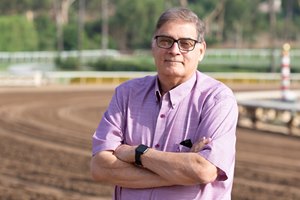CHRB Requires Plan From Los Alamitos to Curb Fatalities


During an emergency meeting of the California Horse Racing Board July 10, regulators passed a motion that will permit Los Alamitos Race Course to continue racing on a probationary status for 10 calendar days. After that period, the board will reconvene July 20 to assess a required plan from the track to reduce a spike in fatalities.
According to CHRB statistics, 19 horses have died from racing or training at Los Alamitos in 2020, including eight since May 26. The Orange County track conducts a regular nighttime mixed-breed meet of Quarter Horses and Thoroughbreds in addition to periodic afternoon meets exclusive to Thoroughbreds. It also serves as a major training facility.

Over the course of the teleconferenced meeting lasting nearly two hours, the board heard comments from Los Alamitos' legal counsel, some industry stakeholders and horsemen, plus its own veterinarians. None could specifically pinpoint the reason for the rise in catastrophic injuries, though the track surface was not blamed.
Hall of Fame trainer Bob Baffert said he keeps 70 to 80 Thoroughbreds in training at Los Alamitos year-round and has stabled some of his champions there before moving them to race at Santa Anita Park or Del Mar.
"That track surface is probably the kindest of all the surfaces in Southern California, so I can't see it being the track surface," he told commissioners.
Dr. Rick Arthur, the equine medical director for the CHRB, raised no issue with the surface and praised Los Alamitos track veterinarian Dr. Rebecca Fitzgerald. Necropsies of fatally injured horses show the potential for improvement in other areas, he said.
"What I have reviewed on these cases so far are the same problems we see everywhere in racing: questionable training and horse management and questionable veterinary practices," he said. "For whatever reasons, those have been especially problematic this year at Los Alamitos. That has to change, but this is not a Los Alamitos problem.
"We have two items on (the board's July 16) agenda to address what I see are further steps on the fundamental reforms to racing this board has already undertaken. One is a long-overdue continuing education requirement for trainers, and the other is additional regulations on interarticular injections."
Track management from Los Alamitos did not speak during Friday's meeting, which irked some commissioners. An attorney representing Los Alamitos, Drew Couto, spoke on behalf of the track, urging commissioners to examine the fatalities over a larger sample of data representing the 2019-20 fiscal year. He called the spike in recent numbers a "cluster" that has happened over varying periods at other tracks, including Santa Anita.
That data showed 32 racing and training fatalities from July 2019 through June 2020, one fewer than during the same time period the year before, according to CHRB executive director Scott Chaney. Also during that time period, there was a sharp rise in fatalities that fell outside the scope of racing or training, a classification the CHRB monitors in a category labeled "other." Horses that die from colic, for example, are tracked there.
Fatalities in this "other" category grew from nine in the fiscal year 2018-19 to 21 during the just-completed fiscal year, Chaney said.
Commissioners asked Fitzgerald whether she felt understaffed as the sole examining regulatory veterinarian at Los Alamitos, to which she replied that she had no issue. She said that because she examines all the horses there, she has a familiarity with them from race to race that might not exist if multiple veterinarians were rotating examinations.
Although the mixed-breed meet does not have a panel that flags at-risk horses for further examination, Fitzgerald said her assistant looks for these types to scrutinize, and track stewards also provide her with a list of horses to give a detailed examination.
"We certainly have seen some unusual cases at Los Alamitos this year—and by unusual, I don't mean suspicious. I mean they are just oddities and very unfortunate oddities. I'm not diminishing the importance of them," Arthur said. "But they're certainly nothing that you can put your finger on to say, 'Ah, we do this, we're going to solve the problem'—except for, as I mentioned, the multiple interarticular injections that for some reason are so common in Quarter Horses at Los Alamitos."
As usual at CHRB meetings, numerous anti-racing activists spoke, calling for the board to suspend racing, this time at Los Alamitos. The board ultimately chose to continue racing there while the track formulates a safety plan, though commissioner Wendy Mitchell voted against that motion.
"Obviously, it's not acceptable that there are all these increases" in fatalities, she said. "If that takes some time of them not racing to come up with a plan, then I would be for that."
